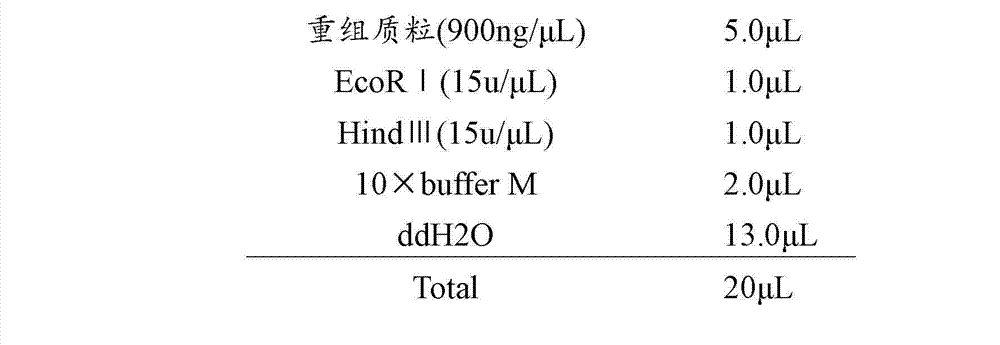Method for preparing inhibitor for reducing tobacco nicotine synthesis by using double-stranded RNA interference technology, and applications of inhibitor
A technology of RNA interference and inhibitors, applied in botany equipment and methods, chemicals for biological control, applications, etc., can solve problems such as difficult promotion and application, and achieve low cost, broad industrialization prospects, no residue and Effects of Environmental Pollution
- Summary
- Abstract
- Description
- Claims
- Application Information
AI Technical Summary
Problems solved by technology
Method used
Image
Examples
Embodiment 1
[0026] 1. Extraction of total RNA from tobacco roots
[0027] The main tobacco variety Yunyan 87 in my country was used as the material. After washing the young roots with sterile water, the total RNA of tobacco was extracted with TRNzol Total RNA Reagent.
[0028] 1) Take 0.1 g of young tobacco root and grind it sufficiently in liquid nitrogen for 55 seconds, and add 1 mL of TRNzol;
[0029] 2) Place the homogenate sample at 15-30°C for 5 minutes to completely separate the nucleic acid-protein complex; 3) Centrifuge at 12,000rpm for 10m at 4°C, and take the supernatant;
[0030] 4) Add 0.2mL chloroform, cover the tube cap, shake vigorously for 15s, and place at room temperature for 3min;
[0031] 5) Centrifuge at 4°C, 12000rpm for 10~15m, the sample will be divided into three layers: the yellow organic phase, the middle layer and the upper colorless water phase, RNA is mainly in the water phase, transfer the water phase to a new centrifuge tube;
[0032] 6) Add an equal vol...
Embodiment 2
[0189] application of the inhibitor nornicotine,
[0190] Two days before tobacco topping, the inhibitor containing 30ug / mL dsRNA was sprayed on the root surface of the tobacco in the experimental group before 9 am or after 5 pm, and the application rate was 10mL / plant. The experimental group and the control group each have 4 groups, and each group has 100 tobacco plants, which are harvested and baked after normal maturity, and the nicotine content in the tobacco leaves is sampled to determine the content of nicotine. The experimental results showed that compared with the control, the nicotine content in the middle leaves decreased by 43.36%, and the nicotine content in the upper leaves decreased by 55.42%, see Table 1.
[0191] Table 1 Nicotine content in tobacco leaves of root-applied PMT gene partial sequence hairpin dsRNA preparation (%)
[0192]
[0193] Note: * indicates that the difference between the data in the same column and the control reaches a significant lev...
Embodiment 3
[0195] In this example, 10 mL / plant of the inhibitor containing 30 ug / mL dsRNA was applied to the leaves of tobacco. Others are identical with embodiment 2. The experimental results showed that compared with the control, the nicotine content in the middle leaves decreased by 18.92%, and the nicotine content in the upper leaves decreased by 23.31%.
[0196] Table 2 Nicotine content (%) in tobacco leaves of hairpin dsRNA preparation of leaf-applied PMT gene partial sequence
[0197]
PUM
 Login to View More
Login to View More Abstract
Description
Claims
Application Information
 Login to View More
Login to View More - R&D
- Intellectual Property
- Life Sciences
- Materials
- Tech Scout
- Unparalleled Data Quality
- Higher Quality Content
- 60% Fewer Hallucinations
Browse by: Latest US Patents, China's latest patents, Technical Efficacy Thesaurus, Application Domain, Technology Topic, Popular Technical Reports.
© 2025 PatSnap. All rights reserved.Legal|Privacy policy|Modern Slavery Act Transparency Statement|Sitemap|About US| Contact US: help@patsnap.com



